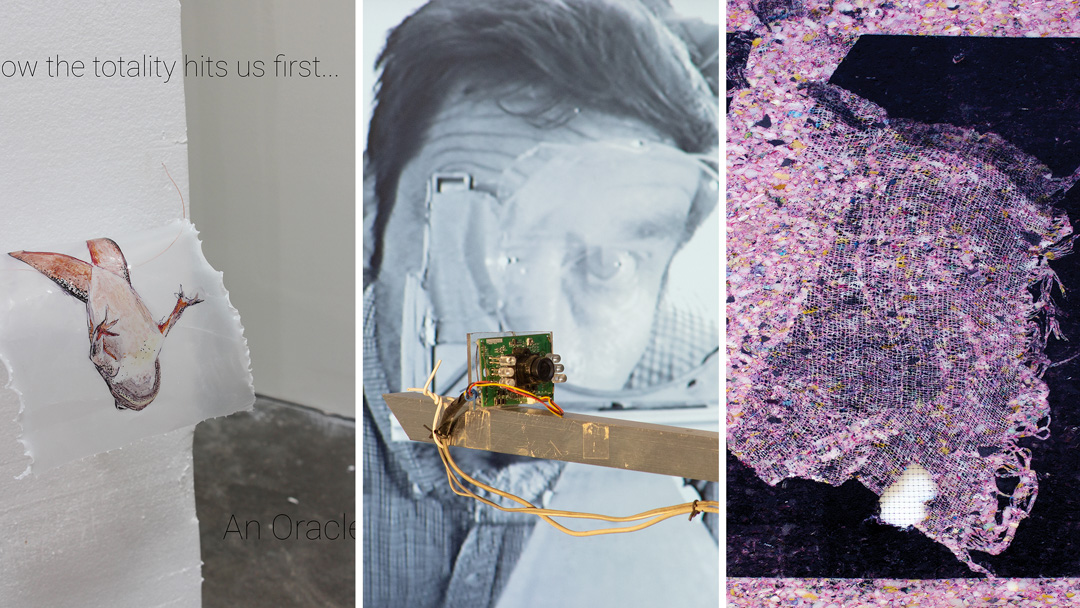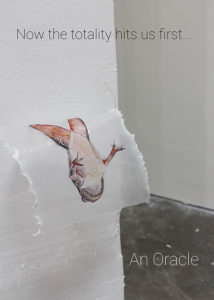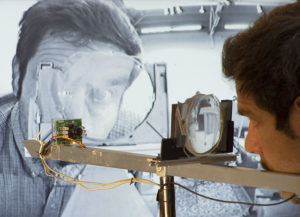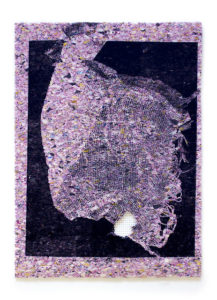
April 24, 2019
FOR IMMEDIATE RELEASE
San Francisco, CA–The Artist in Residence Program at Recology San Francisco will host an exhibition and reception for current artists-in-residence Alicia Escott, Kal Spelletich, and UC Berkeley student artist Ricki Dwyer on Friday, May 17, from 5-8pm and Saturday, May 18, from 1-3pm. Additional viewing hours will be held on Tuesday, May 21, from 5-7pm, with a gallery walk-through with the artists at 6pm. This exhibition will be the culmination of four months of work by the artists who have scavenged materials from the dump to make art and promote recycling and reuse.
Alicia Escott
Now the Totality Hits Us First: An Oracle 
Alicia Escott looks to the Recology facility’s surroundings to make work that illuminates the precarious, intertwined relationship between humans and the local ecology. San Bruno Mountain, rising to the west, was once cited by famed biologist E. O. Wilson as one of 18 biological “hotspots” on the planet and is home to an amazing diversity of species. Escott contemplates how the Bayshore area’s historic role as a dumping ground made the region less desirable, resulting in San Bruno Mountain being spared from development. Or, as Escott describes it, “the worst of us saving the best of us.”
Escott represents images of species that populate the region in paintings on scavenged plastic, and presents them in sculptural installations that incorporate items including circuit boards, Styrofoam, electrical cable, and broken glass. Local host plants she has grown in Recology compost also become a part of the work, integrating the surrounding habitat. Escott uses these varied materials to show entanglements between the environment and civilization that have taken place over time, and that have themselves redefined the natural world. The backdrop for all of the work is our current moment of profound global change Escott uses the word “oracle” to describe the dump pile as a sort of being who knows more about us at this current moment than we do, as it is a receptacle for the things we can’t deal with or don’t want to look at any longer. Escott’s work seeks an earnest dialogue with this oracle as the precarity of our time comes into ever sharper focus, asking it if indeed our worst impulses will somehow save the best of us.
Alicia Escott has been an artist-in-residence at the Djerassi Resident Artists Program and the Anderson Ranch Residency. She has exhibited at Yerba Buena Center for the Arts, the Berkeley Art Museum, the Museum of Contemporary Art in Santa Barbara, and the Hayward Gallery in London. She holds an MFA from the California College of the Arts, is a founding member of 100 Days Action, and is half of the two-person collaborative The Bureau of Linguistic Reality.
 Kal Spelletich
Kal Spelletich
Molecular Vibrations of the Radiant Body: Reverse Engineering a Portrait of Human Energy into Light, Sound and Machine Movements
Kal Spelletich creates a series of kinetic, mechanical sculptures that celebrate the scientific method, asserting that science is indeed real and an underlying force in the advances that inform our daily lives. Employing pendulums, telescopes, and sound and light waves, Spelletich references discoveries by Newton, Galileo and other scientific philosophers, but brings a 21st century e-waste sensibility to the work. His machines also address the poetic nature of scientific discovery and metaphorically illustrates how, just as light and sound waves can be sent into the world, so also can ideas and emotions radiate out, with the potential for activating positive change. And to illustrate this point, Spelletich’s works are primarily interactive in nature, often using sensors that require you, the viewer, to be the instigating force.
Many of the pieces have a relationship to sound and music. In homage to the Miles Davis Quintet, a grouping of five machines, created from materials including guitar keys, springs and cymbals, produce their own music when activated by light. Parts from keyboards, amps, and speakers have been used in other works. Spelletich has also “mined” silver from the pile, from sources including chipboards and cutlery for a silver pendulum that is activated when a fork is picked up. The dump pile itself has also been a source of inspiration, activating some of his machines and serving as the subject of a video, filmed with a drone in collaboration with Eddie Codel, that surveys the surface of the pile as one would explore the contours of a mountain range.
During his 29-year-career in the Bay Area, Kal Spelletich has been a pivotal figure in the machine art and robotics community, collaborating with scientists and musicians, and working as an educator and curator. He has exhibited at the deYoung Museum, SFMOMA, and the Exploratorium in San Francisco; Deitch Projects and the Knitting Factory in New York; and in venues in Germany, Czechoslovakia, and Croatia. He has been the subject of press in the New York Times and on PBS, holds an MFA from the University of Texas at Austin, and is represented by Catharine Clark Gallery.
Ricki Dwyer
SOFT/WET
In 2013, a loom and a collection of hand-dyed yarns were donated to the Recology Artist in Residence Program. After six years in storage, the loom was assembled this February by UC Berkeley graduate student artist Ricki Dwyer, who has used it to create a series of works from the donated yarns in combination with scavenged materials.
Dwyer has produced a large, sculptural weaving, along with associated smaller woven works. The use of double weaves in the pieces have resulted in forms that are suggestive of coming together and passing through. Work speaks to the intersection of two people, such as Dwyer and the previous owner of the loom, as well as the meeting points and divergences in our own ongoing construction of self. Soft, pliable cloth serves as a stand-in for the human body and its mutability. Dwyer explores the many ways in which cloth can be read—hung on the wall it’s a painting, seen on the floor it’s a rug, worn on the body it’s clothing, illustrating a transformative versatility.
A range of pink hues, golden tones, strong blacks, and gradations of color appear in the works. From the weavings themselves, Dwyer has produced monoprints on found materials, including carpet padding and rosin paper. The prints act as form and structure studies of the woven works and emphasize the act of weaving itself, while also highlighting the materiality of the printing process and the liquid inks used.
Dwyer will receive an MFA from the University of California, Berkeley in May, and holds a BFA from the Savannah College of Art and Design. They have exhibited in the Bay Area at Root Division, Adobe Books, and Artists Television Access and were the recipient of a Murphy and Cadogan Contemporary Art Award. Dwyer has been an artist-in-residence at Andrea Zittel’s AZ West residency in Joshua Tree, and Standard Projects in Hortonville, Wisconsin.
When:
Reception-Friday, May 17, 2019, 5-8pm
Reception-Saturday, May 18, 2019, 1-3pm
Additional viewing hours-May 21, 2019, 5-7pm with gallery walk-through with artists at 6pm at 401 Tunnel Avenue
Where:
Art Studio, 503 Tunnel Avenue and Environmental Learning Center, 401 Tunnel Avenue, San Francisco, CA
Admission is free and open to the public, all ages welcome, wheelchair accessible.
About the Recology Artist in Residence Program
The Artist in Residence Program at Recology San Francisco was established in 1990 to encourage the conservation of natural resources and instill a greater appreciation for the environment and art in children and adults. Artists work for four months in studio space on site, use materials recovered from the Public Reuse and Recycling Area, and speak to students and the general public. Over 190 Bay Area artists have completed residencies. Applications are accepted annually, June through August.
Contacts:
Deborah Munk
dmunk@recology.com
Micah Gibson (for hi res images)
mgibson@recology.com
Sharon Spain
sspain@recology.com
####